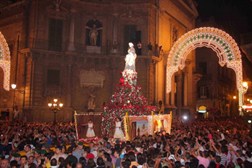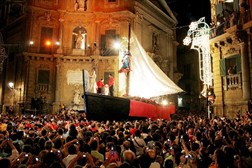The Feast of Santa Rosalia in Palermo
 The Feast of Saint Rosalia in Palermo, called ‘u fistinu (the feast), is a religious ceremony that commemorates the saving of the city from the plague in 1624 and since then it has been the bond that links the city to the the saint, whose intervention is attributed for the end of the pestilence, which then elected her its patron saint. Prior to that time, in fact, Palermo had other patron saints. On the four façades of the buildings on the square in the famous Piazza Vigliena (named after the viceroy of the time, the Marquis of Villena), also known as the Quattro canti (Four Corners, photo), built between 1609 and 1620, one can admire the statues of the patron saints of the city at that time: Saints Cristina, Olivia, Agatha and Nympha.
The Feast of Saint Rosalia in Palermo, called ‘u fistinu (the feast), is a religious ceremony that commemorates the saving of the city from the plague in 1624 and since then it has been the bond that links the city to the the saint, whose intervention is attributed for the end of the pestilence, which then elected her its patron saint. Prior to that time, in fact, Palermo had other patron saints. On the four façades of the buildings on the square in the famous Piazza Vigliena (named after the viceroy of the time, the Marquis of Villena), also known as the Quattro canti (Four Corners, photo), built between 1609 and 1620, one can admire the statues of the patron saints of the city at that time: Saints Cristina, Olivia, Agatha and Nympha.
Legend has it that while fever was ravaging the town a hunter, one Vincenzo Bonello, while he was on Mount Pellegrino (the mountain near the city of Palermo), had a vision of a saintly virgin recluse of the twelfth century, Rosalia, who showed him her place of hermitage, a cave nearby. Bonello confirmed that the bones found in the cave were the mortal remains of Rosalia. Believing Bonello’s story, a solemn procession was led by the cardinal, on 6 June 1625, and brought the bones of Saint Rosalia to Palermo’s Cathedral. Coinciding with the cult of the virgin recluse, organized by the Jesuits, the plague ceased to rage on the population.
Rosalia’s being named the city’s patron coincides with these events and her elevation to sainthood, promoted by the Jesuits, on 26 January 1630. A tradition sprang up which held that the new saint had in fact been a wealthy noble who chose poverty, belonging to the Sinibaldi family who were lords of Quisquina, descendants of Charlemagne who had intermarried with the Norman King Roger. The town’s nobility could then be identified with the virgin recluse who died in poverty.
The relics of the saint, placed in a silver and glass casket, began to be ritually carried in procession, giving rise to the feast. As in other Sicilian towns (Trapani, Catania), the feast of Saint Rosalia tended to incorporate the existing ceremony of the cilii, large candles that were offered by the craft guilds and craftsmen to Our Lady. In this way craftsmen became involved in the festival: in 1635 and the barbers and shoemakers founded the confraternity of Santa Rosalia dei sacchi (Saint Rosalia of the bags) which was responsible for carrying the effigy of the saint in procession to the Jesuit Church.
 Over time a series of celebrations evolved and ‘u fistinu was divided into several days. The most devotional aspect of the feast takes place on 15 July, with the procession of the casket containing the relics of Saint Rosalia. On 14 July, however, Saint Rosalia’s triumphant procession takes place, prepared by various activities carried out in the previous days. On that occasion, the statue of the saint is carried from the Palace of the Normans (the ancient seat of the kings and viceroys of Sicily and after them of government authorities) to the sea. This part of the feast has undergone numerous modifications over the course of time. In 1686 the small chariots that form the procession were accompanied by a wagon pulled by mules or oxen, a Baroque machine of massive proportions, which, from 1701, took on the form of a ship (photo). This motif, even if it has been amended, remains central to the festinu; as well as the use of the colour white (purity) and the theme of roses, whose petals are repeatedly thrown at the feet of the saint. The feast is accompanied by music and rhymed songs of devotion, with recurring cries and a spectacular fireworks display.
Over time a series of celebrations evolved and ‘u fistinu was divided into several days. The most devotional aspect of the feast takes place on 15 July, with the procession of the casket containing the relics of Saint Rosalia. On 14 July, however, Saint Rosalia’s triumphant procession takes place, prepared by various activities carried out in the previous days. On that occasion, the statue of the saint is carried from the Palace of the Normans (the ancient seat of the kings and viceroys of Sicily and after them of government authorities) to the sea. This part of the feast has undergone numerous modifications over the course of time. In 1686 the small chariots that form the procession were accompanied by a wagon pulled by mules or oxen, a Baroque machine of massive proportions, which, from 1701, took on the form of a ship (photo). This motif, even if it has been amended, remains central to the festinu; as well as the use of the colour white (purity) and the theme of roses, whose petals are repeatedly thrown at the feet of the saint. The feast is accompanied by music and rhymed songs of devotion, with recurring cries and a spectacular fireworks display.
Thus a seminal element of the fistinu is the separation between a playful feast which has maintained a decidedly symbolic allure to it with a Baroque ephemeral apparatus ephemeral, and the clearly religious aspect of the celebrations. In the triumph of 14 July, the city authorities have always played an important role up to the present day, choosing the most important decorators and architects to be involved in it. In 1896 the wagon was invented by Giuseppe Pitrè, the great scholar of Sicilian folk traditions. On that occasion, he designed a machine of such colossal dimensions that it could not pass through the centre of the city. Even in more recent times, the municipal authorities have turned to architects and famous entertainers and representative of the world of culture to design the triumphal parade. A Baroque feast, ‘u fistinu, is renewed every year and it is never the same.
